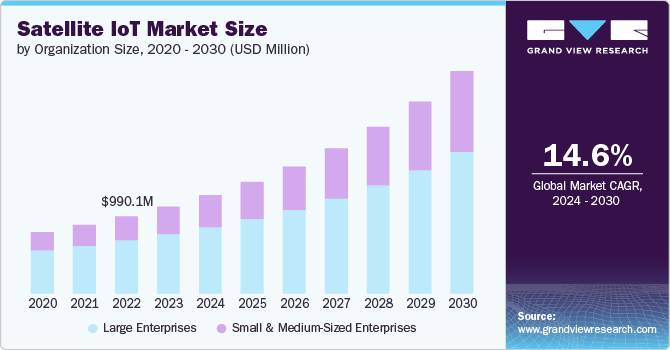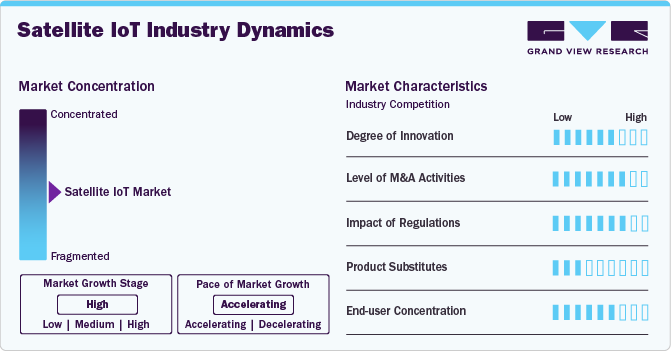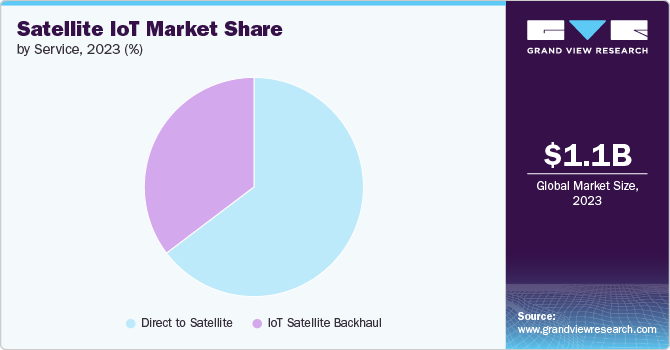
Satellite IoT Market Size, Share & Trends Analysis Report By Service (Direct to Satellite, IoT Satellite Backhaul), By End-use (Defense, Energy & Utilities), By Organization Size, By Region, And Segment Forecasts, 2024 - 2030
- Report ID: GVR-4-68040-382-7
- Number of Report Pages: 150
- Format: PDF, Horizon Databook
- Historical Range: 2018 - 2023
- Forecast Period: 2024 - 2030
- Industry: Technology
Satellite IoT Market Size & Trends
The global satellite IoT market size was estimated at USD 1.12 billion in 2023 and is expected to grow at a CAGR of 14.6% from 2024 to 2030. The proliferation of IoT applications across various industries, such as agriculture, transportation, and energy, is a significant market growth driver. These sectors increasingly rely on IoT devices to monitor, control, and optimize operations. Satellite IoT provides connectivity in remote and underserved areas where terrestrial networks are unavailable or unreliable. This capability enables seamless data transmission and device management, ensuring continuous operation and improving efficiency, thereby driving market growth.

Moreover, the market is benefiting significantly from technological advancements in satellite communications, such as the development of low-earth orbit (LEO) satellites. LEO satellites can provide higher bandwidth and lower latency communications compared to traditional geostationary satellites. This improvement in the quality of service makes satellite IoT solutions more attractive for a wide range of applications, including real-time asset tracking and high-speed data transmission, fueling market growth.
Governments and defense agencies across the globe rely extensively on satellite technology for secure and reliable communication, navigation, and surveillance. With an increasing focus on enhancing national security infrastructure, there is a surge in demand for satellite IoT technologies to support various military operations and projects. These initiatives require robust, secure, and fail-proof connectivity fulfilled by satellite communications, thus driving market expansion.
In addition, the global drive towards digital transformation and automation across industries has led to a surge in IoT adoption. Satellite IoT plays a crucial role in enabling connectivity for IoT devices located in harsh or remote environments where traditional connectivity methods are difficult to function. This widespread adoption of IoT solutions necessitates the integration of satellite technology to ensure seamless global coverage, thereby propelling market growth in the coming years.
Furthermore, the surge in data-driven decision-making practices across industries propels the demand for Satellite IoT. Organizations leverage IoT data to gain insights, optimize processes, and enhance operational efficiency. Satellite IoT enables the collection and transmission of critical data from remote or mobile assets, ensuring decision-makers can access real-time information. This capability supports predictive maintenance, asset tracking, environmental monitoring, and other applications, propelling the market forward.
Market Concentration & Characteristics
Degree of innovation in the market significantly drives its expansion by enabling more efficient, reliable, and global connectivity solutions. These advancements improve data collection and transmission across various industries, enhancing operational efficiencies and enabling new business models.
Regulations in the market play a significant role in shaping the development and deployment of satellite-based connectivity solutions. They ensure the sustainable use of orbital slots and frequency bands and aim to protect the integrity of satellite communications, fostering a secure and competitive market environment.

The market is also being influenced by the rising number of mergers and acquisitions, which help companies increase market share, expand the customer base, and strengthen product portfolios.
The presence of product substitutes in the market introduces competition, potentially reducing the demand for satellite-based solutions in favor of terrestrial or alternative communication technologies. This competition can drive innovation, leading to improved services and cost-effective solutions for end-users.
High end-user concentration in the market can lead to increased dependency on a limited number of clients, which may influence pricing, service customization, and market stability. On the other hand, it can drive focused innovation and service improvement to meet the specific needs of these key clients.
Organization Size Insights
The large enterprises segment dominated the market in 2023 with a market share of around 68% due to increasing demand for global connectivity, asset tracking, and remote monitoring solutions. These enterprises leverage satellite IoT for real-time data collection and analysis, improving operational efficiency and decision-making. The expanding use of satellite IoT in industries such as logistics, agriculture, and energy is driving this growth. In addition, advancements in satellite technology and reduced costs are making it more accessible for large enterprises to adopt and integrate IoT solutions, thereby driving segment growth.
The small & medium enterprises (SMEs) segment is expected to record the highest CAGR of 16.8% from 2024 to 2030. The segment growth is due to the increasing affordability and accessibility of satellite technology. These enterprises leverage satellite IoT solutions for asset tracking, remote monitoring, and agricultural management applications. The advancements in satellite technology have reduced costs, making it feasible for SMEs to adopt and integrate these solutions. This trend is further propelled by the rising demand for efficient, real-time data across various sectors, enhancing operational efficiencies and competitive advantage for SMEs, further driving the segment growth.
End-use Insights
Defense held the highest revenue share in 2023, driven by increasing demand for advanced communication and surveillance capabilities. Military operations rely heavily on satellite IoT for real-time data exchange, asset tracking, and remote monitoring, enhancing operational efficiency and situational awareness. Integrating IoT technology into defense infrastructure supports mission-critical applications such as unmanned systems and battlefield management. Furthermore, government investments and collaborations with private sectors are boosting developing and deploying satellite IoT solutions in defense.
Agriculture is estimated to register the highest growth rate from 2024 to 2030 due to the increasing adoption of precision farming techniques. Satellite IoT enables real-time monitoring of crop health, soil conditions, and weather patterns, enhancing productivity and efficiency. Farmers are leveraging these technologies to optimize resource use, reduce costs, and improve yields. In addition, integrating satellite IoT with other emerging technologies, such as drones and AI, further drives its adoption in agriculture.
Service Insights
The direct to satellite segment held the highest revenue share in 2023, attributed to advancements in satellite technology and increasing demand for global connectivity. Companies are leveraging low Earth orbit (LEO) satellites to provide reliable, low-latency connections directly to IoT devices, bypassing traditional ground-based infrastructure. This expansion is driven by the need for seamless communication in remote and underserved areas, enhancing applications in industries such as agriculture, logistics, and environmental monitoring. Subsequently, the market is witnessing increased investment and innovation, fueling the market expansion.

The IoT satellite backhaul segment is estimated to register the highest growth rate from 2024 to 2030 due to the increasing need for reliable and widespread connectivity in remote and underserved regions. The demand for efficient data transmission and real-time communication for various applications, including agriculture, environmental monitoring, and asset tracking, drives this growth. Advancements in satellite technology and LEO satellite deployment enhance coverage and reduce latency, further boosting the segment. Furthermore, the rise in IoT device adoption globally fuels the expansion of IoT satellite backhaul services, thereby driving the segment growth.
Regional Insights
The satellite IoT market in North America accounted for the highest revenue share of nearly 40% in 2023, driven by increased investment in technological infrastructure by both the public and private sectors. The region benefits from a strong ecosystem of tech innovators and startups focusing on integrating IoT with satellite communication to address the need for remote area connectivity and advanced defense and security systems. Moreover, the growing demand for IoT applications in agriculture, logistics, and environmental monitoring propels market expansion.
U.S. Satellite IoT Market Trends
The satellite IoT market in the U.S. is anticipated to grow at a CAGR of 13.7% from 2024 to 2030. The U.S. is leading the market with its robust aerospace and defense sectors, driving demand for advanced satellite communications and IoT integration. Significant investments in R&D and a strong push for connectivity in remote and rural areas further bolster the market's growth.
Asia Pacific Satellite IoT Market Trends
The satellite IoT market in Asia Pacific is anticipated to grow at the highest CAGR of 17.9% from 2024 to 2030, fueled by the vast rural expanses and the urgent need for remote connectivity solutions. Governments across the region are heavily investing in space and satellite technologies, aiming to improve telecommunications infrastructure, which is pivotal for disaster management, rural development, and enhancing broadband coverage.
India satellite IoT market is estimated to record a significant growth rate from 2024 to 2030. The government's focus on enhancing telecommunications infrastructure and ambitious space exploration missions propel India's market growth. The need for agricultural productivity and rural connectivity also plays a significant role in adopting satellite IoT technologies.
The satellite IoT market in China is expected to grow considerably from 2024 to 2030. China's rapid advancements in space technology and a government-led push for digital infrastructure development are key growth drivers. The country's large-scale deployment of satellite IoT for urban management and environmental monitoring catalyzes its market expansion.
Japan satellite IoT market is projected to witness a considerable growth rate from 2024 to 2030. In Japan, disaster management and elderly care are significant factors driving the market. The country's technological innovation and the government's investment in space technologies and IoT integration are crucial for its growth.
Europe Satellite IoT Market Trends
Satellite IoT market in Europe accounted for a notable revenue share of around 26% in 2023. Europe's market is expanding, driven by a strong emphasis on sustainability, smart city projects, and stringent regulatory frameworks aiming for high environmental standards. The push towards IoT-enabled satellite technology for efficient resource management and urban development and to meet climate goals is fostering innovation and cross-sector partnerships.
The UK satellite IoT market is projected to grow considerably from 2024 to 2030. The UK's market growth is fueled by its focus on environmental monitoring and smart city initiatives requiring advanced IoT solutions. Moreover, the supportive regulatory framework and investments in space and digital infrastructure stimulate market development.
The satellite IoT market in Germany is expected to record significant growth from 2024 to 2030. Germany's market benefits from its strong automotive industry and its leadership in Industry 4.0, where satellite IoT plays a vital role in logistics and supply chain management. The country's commitment to innovation and technology-driven environmental policies also propel market growth.
Middle East and Africa (MEA) Satellite IoT Market Trends
The satellite IoT market in the Middle East and Africa (MEA) region is anticipated to grow at a significant CAGR of 15.7% from 2024 to 2030. The MEA is seeing a steady increase in market growth, fueled by the strategic modernization of key sectors such as oil and gas, where satellite IoT plays a critical role in remote monitoring and asset management. The region's ambitious infrastructure projects, including smart cities and transportation networks, rely heavily on the seamless connectivity of satellite IoT solutions.
Saudi Arabia satellite IoT in energy market accounted for a considerable revenue share in 2023. Saudi Arabia's market growth is largely driven by the modernization of its oil and gas sector, and the Saudi Vision 2030 plan focuses on smart city developments. The need for satellite IoT technologies in remote operations and monitoring across vast desert areas is particularly significant.
Key Satellite IoT Company Insights
Some key players operating in the market are Iridium Satellite LLC, Northrop Grumman Corporation, and Thales S.A.
-
Northrop Grumman Corporation, a global aerospace and defense technology company, commands a commanding presence in the industry owing to its innovative solutions and persistent focus on meeting its customers' critical needs. It operates across multiple segments, including aerospace systems, mission systems, and defense services, providing advanced technologies that support national security and commercial enterprises.
-
Thales S.A. is a major technology company based in Paris, France. It focuses on key sectors like defense, aerospace, transportation, and digital security and is dedicated to creating innovative solutions for a safer world. With a strong emphasis on research and development, Thales aims to support its customers by providing the information and tools to make smart decisions and respond effectively in tough situations.
Myriota Pty Ltd., Inmarsat Group, and Kepler Communications Inc., among others, are some of the emerging market participants.
-
Myriota Pty Ltd. is at the forefront of global innovation in the Internet of Things (IoT) sector, offering unique satellite connectivity solutions to track and manage assets in some of the world’s most remote locations. The company has developed a technology platform that enables reliable, low-cost, and long-battery-life connectivity for small-scale IoT devices across various industries.
-
Kepler Communications Inc. is an innovative telecommunications company dedicated to improving satellite communications with its cutting-edge network of satellites. Based in Toronto, Canada, Kepler's mission is to build an infrastructure that facilitates seamless data transfer for devices anywhere, whether in remote areas or bustling urban centers. The company's innovative approach aims to bridge the connectivity gap, offering reliable, high-capacity internet and data services.
Key Satellite IoT Companies:
The following are the leading companies in the satellite iot market. These companies collectively hold the largest market share and dictate industry trends.
- Iridium Satellite LLC
- ORBCOMM Inc.
- Globalstar, Inc.
- Northrop Grumman Corporation
- Swarm Technologies Inc.
- Inmarsat Group
- Kepler Communications Inc.
- Myriota Pty Ltd.
- Thales S.A.
- Airbus SE
Recent Developments
-
In July 2024, Azercosmos, the national space agency of Azerbaijan, partnered with technology firm DynaSys Networks, integrating their satellite networks with DynaSys' IoT ecosystem. This move is set to enhance IoT application management in the EMEA regions, boosting efficiency, optimizing resources, and creating new revenue opportunities. The partnership aims to advance a smarter, more connected future.
-
In February 2024, EMnify GmbH, a provider specializing in cloud-based IoT connectivity, announced the general availability of integrated cellular and satellite IoT connection on a singular emnify IoT eSIM. This innovation, named SuperNetwork SatPlus, is combined within the emnify SuperNetwork, a premier IoT cellular connection service that delivers expansive multi-network coverage across more than 180 countries.
-
In March 2023, Monogoto, an internet-based mobile network provider, partnered with Skylo Technologies, a ground-based network service company, to offer cost-effective satellite links for tracking assets. This partnership aims to enable developers to integrate satellite communication into public and private networks via Monogoto Cloud.
Satellite IoT Market Report Scope
|
Report Attribute |
Details |
|
Market size value in 2024 |
USD 1.26 billion |
|
Revenue forecast in 2030 |
USD 2.85 billion |
|
Growth rate |
CAGR of 14.6% from 2024 to 2030 |
|
Actual data |
2018 - 2023 |
|
Forecast period |
2024 - 2030 |
|
Quantitative units |
Revenue in USD million/billion and CAGR from 2024 to 2030 |
|
Report coverage |
Revenue forecast, company ranking, competitive landscape, growth factors, and trends |
|
Segments covered |
Organization size, service, end-use, region |
|
Regional scope |
North America; Europe; Asia Pacific; Latin America; Middle East & Africa |
|
Country scope |
U.S.; Canada; Mexico; Germany; UK; France; Italy; China; Japan; India; Australia; South Korea; Brazil; UAE; Saudi Arabia; South Africa |
|
Key companies profiled |
Iridium Satellite LLC; ORBCOMM Inc.; Globalstar, Inc.; Northrop Grumman Corporation; Swarm Technologies Inc.; Inmarsat Group; Kepler Communications Inc.; Myriota Pty Ltd.; Thales S.A.; Airbus SE |
|
Customization scope |
Free report customization (equivalent up to 8 analysts working days) with purchase. Addition or alteration to country, regional & segment scope. |
|
Pricing and purchase options |
Avail customized purchase options to meet your exact research needs. Explore purchase options |
Global Satellite IoT Market Report Segmentation
This report forecasts and estimates revenue growth at the global, regional, and country levels along with analyzes the latest market trends and opportunities in each one of the sub-segments from 2018 to 2030. For this study, Grand View Research has further segmented the global satellite IoT market report based on organization size, service, end-use, and region:
-
Organization Size Outlook (Revenue, USD Million, 2018 - 2030)
-
Large Enterprises
-
Small & Medium Sized Enterprises
-
Service Outlook (Revenue, USD Million, 2018 - 2030)
-
Direct to Satellite
-
IoT Satellite Backhaul
-
-
End-use Mode Outlook (Revenue, USD Million, 2018 - 2030)
-
Defense
-
Energy & Utilities
-
Agriculture
-
Environmental
-
Transport and Logistics
-
Marine
-
Others
-
-
Regional Outlook (Revenue, USD Million, 2018 - 2030)
-
North America
-
U.S.
-
Canada
-
Mexico
-
-
Europe
-
Germany
-
UK
-
France
-
Italy
-
-
Asia Pacific
-
Japan
-
China
-
India
-
Australia
-
South Korea
-
-
Latin America
-
Brazil
-
-
Middle East and Africa (MEA)
-
UAE
-
Saudi Arabia
-
South Africa
-
-
Frequently Asked Questions About This Report
b. The global satellite IoT market size was estimated at USD 1.12 billion in 2023 and is expected to reach USD 1.26 billion in 2024.
b. The global satellite IoT market is expected to grow at a compound annual growth rate of 14.6% from 2024 to 2030 to reach USD 2.85 billion by 2030.
b. The North America region accounted for the largest share of over 40% in the satellite IoT market in 2023 and is expected to continue its dominance in the coming years.
b. Some key players operating in the satellite IoT market include Iridium Satellite LLC, ORBCOMM Inc., Globalstar, Inc., Northrop Grumman Corporation, Swarm Technologies Inc., Inmarsat Group, Kepler Communications Inc., Myriota Pty Ltd., Thales S.A., Airbus SE.
b. Key factors that are driving the satellite IoT market growth include the proliferation of IoT applications across various industries such as agriculture, transportation, and energy.
We are committed towards customer satisfaction, and quality service.
"The quality of research they have done for us has been excellent."




